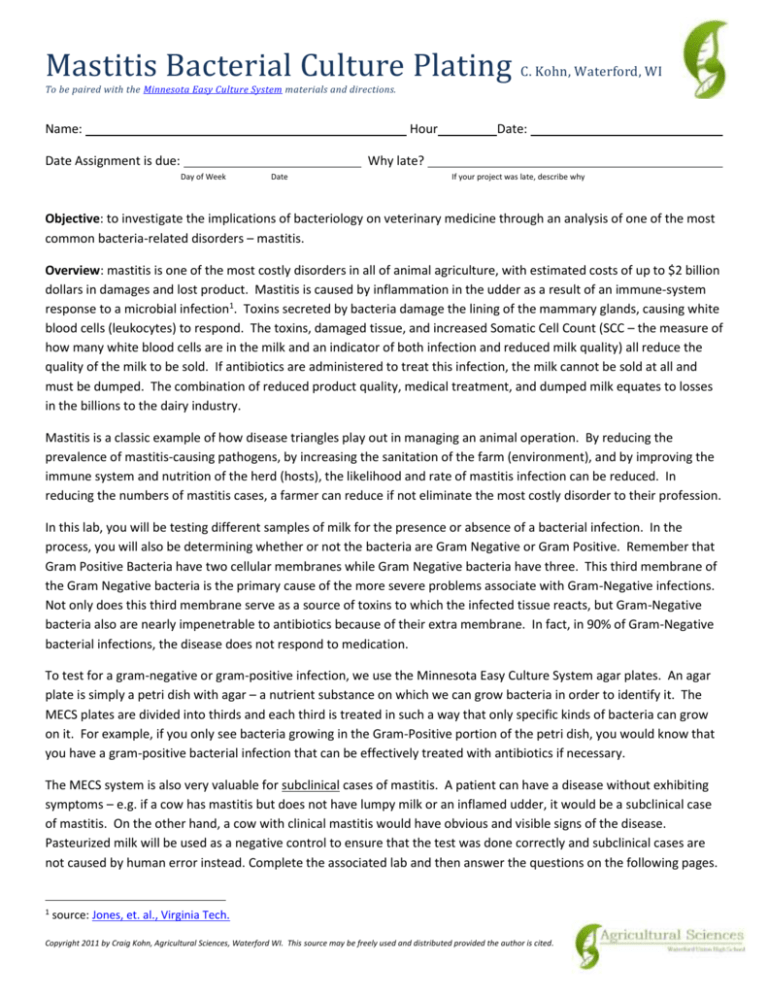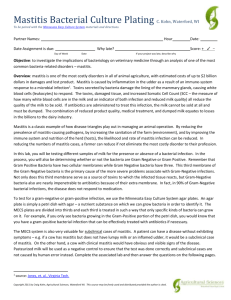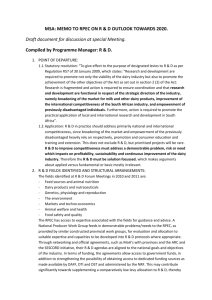Day 2: Reading Plates
advertisement

Mastitis Bacterial Culture Plating C. Kohn, Waterford, WI To be paired with the Minnesota Easy Culture System materials and directions. Name: Hour Date Assignment is due: Date: Why late? Day of Week Date If your project was late, describe why Objective: to investigate the implications of bacteriology on veterinary medicine through an analysis of one of the most common bacteria-related disorders – mastitis. Overview: mastitis is one of the most costly disorders in all of animal agriculture, with estimated costs of up to $2 billion dollars in damages and lost product. Mastitis is caused by inflammation in the udder as a result of an immune-system response to a microbial infection1. Toxins secreted by bacteria damage the lining of the mammary glands, causing white blood cells (leukocytes) to respond. The toxins, damaged tissue, and increased Somatic Cell Count (SCC – the measure of how many white blood cells are in the milk and an indicator of both infection and reduced milk quality) all reduce the quality of the milk to be sold. If antibiotics are administered to treat this infection, the milk cannot be sold at all and must be dumped. The combination of reduced product quality, medical treatment, and dumped milk equates to losses in the billions to the dairy industry. Mastitis is a classic example of how disease triangles play out in managing an animal operation. By reducing the prevalence of mastitis-causing pathogens, by increasing the sanitation of the farm (environment), and by improving the immune system and nutrition of the herd (hosts), the likelihood and rate of mastitis infection can be reduced. In reducing the numbers of mastitis cases, a farmer can reduce if not eliminate the most costly disorder to their profession. In this lab, you will be testing different samples of milk for the presence or absence of a bacterial infection. In the process, you will also be determining whether or not the bacteria are Gram Negative or Gram Positive. Remember that Gram Positive Bacteria have two cellular membranes while Gram Negative bacteria have three. This third membrane of the Gram Negative bacteria is the primary cause of the more severe problems associate with Gram-Negative infections. Not only does this third membrane serve as a source of toxins to which the infected tissue reacts, but Gram-Negative bacteria also are nearly impenetrable to antibiotics because of their extra membrane. In fact, in 90% of Gram-Negative bacterial infections, the disease does not respond to medication. To test for a gram-negative or gram-positive infection, we use the Minnesota Easy Culture System agar plates. An agar plate is simply a petri dish with agar – a nutrient substance on which we can grow bacteria in order to identify it. The MECS plates are divided into thirds and each third is treated in such a way that only specific kinds of bacteria can grow on it. For example, if you only see bacteria growing in the Gram-Positive portion of the petri dish, you would know that you have a gram-positive bacterial infection that can be effectively treated with antibiotics if necessary. The MECS system is also very valuable for subclinical cases of mastitis. A patient can have a disease without exhibiting symptoms – e.g. if a cow has mastitis but does not have lumpy milk or an inflamed udder, it would be a subclinical case of mastitis. On the other hand, a cow with clinical mastitis would have obvious and visible signs of the disease. Pasteurized milk will be used as a negative control to ensure that the test was done correctly and subclinical cases are not caused by human error instead. Complete the associated lab and then answer the questions on the following pages. 1 source: Jones, et. al., Virginia Tech. Copyright 2011 by Craig Kohn, Agricultural Sciences, Waterford WI. This source may be freely used and distributed provided the author is cited. Areas of Interest when reading Plates (Taken from Minnesota Easy Culture System II) There are generally two major areas of interest when reading bacteria culture plates. The first is bacteria identification. Knowing which bacteria is found in the sample will help you decide which antibiotics are appropriate to use on that cow, should you so desire. The second area of interest is colony forming units or how many bacteria are present. When there are more than one colony present, it is that likely the cow is infected with two or more bacteria (if the sample is of high quality). Factor plates are used to identify Gram-positive bacteria (staph, strep, bacillus, corynebacteria, arcanobacteria (actinomyces), and yeasts). MTKT plates select for Streptococcus species. MacConkey plates select for Gram-negative. Day 1: Plating Procedure: Sample mixing: If the sample cannot be plated immediately (within 10-15 minutes) refrigerate or freeze the sample. This is critical to obtaining quality results. Thaw the frozen milk samples in the refrigerator. Make sure the lid is properly sealed. Once the milk sample is thawed, mix each sample vial or tube well by inverting the milk samples approximately 15 times. Sample plating: Avoid touching the plate or cotton end of the sterile swab as this will result in contamination, which will give inaccurate findings. (Open the swab package such that the cotton ends remain covered and only a small portion of the stick is exposed.) Place a sterile cotton swab end in the milk sample, rolling the non-cotton end of the swab between index finger and thumb, for approximately 8 to 10 seconds, or until swab becomes completely saturated. Try to avoid plating clumped milk. If this happens be sure to note where it was so as not to confuse it with bacteria growth. Tri-plates Using the saturated swab spread the milk sample evenly on the surface of each sector on the Tri-plate. Make sure that the entire surface of the agar has been covered. Be sure to re-dip the swab between each section. This will help ensure accurate results. Once the plate has been swabbed, place the lid back on the plate. Place the plate in the incubator upside down (agar is face down or place the plate on its lid) in a 37o C incubator for 18 to 24 hours. Be sure to label each sample (on the bottom of the plate). After 18-24 hours read the “Day 2: Reading plates” section below. Plating methods used in microbiologic analyses of milk samples are somewhat quantitative (a saturated cotton swab contains at least 0.l ml). They are intended to meet the need for recognition of specific microorganisms while giving some relative information as to the number of organisms present in the sample. Day 2: Reading Plates: Tri-plates Milk cultures can be difficult to interpret. A plate swabbed with milk from one quarter should have predominant growth of a single organism because a quarter is rarely infected with more than one organism at a time. (All the growth on the plate should look the same [shiny, round, large, small and the same color]. Milk clumps will appear as irregular masses.) Growth of numerous organisms as evidenced by different colony morphologies (size, shape, and color) indicates contamination or poor sample collection technique. Composite samples may have more than one organism present. If there is more than. Once the organisms have been tentatively identified return the plates to the incubator for an additional 18 hours of incubation. Re-examine the plates after 36-48 hours of growth. Uncontaminated milk samples from a healthy, normal mammary gland contain little or no bacteria. The object when reading plates is to identify and isolate all possible mastitis pathogens. Visually examine the plates, after 18-24 hours of incubation, for the presence of bacteria as evidenced by the presence of colonies. If there is no growth, re-incubate the plates for an additional 24 hours. If no growth is observed after a total of 48 hours the samples can be recorded as a "No Growth. Copyright 2011 by Craig Kohn, Agricultural Sciences, Waterford WI. This source may be freely used and distributed provided the author is cited. 1. What sample did you have? What type of infection did this sample have, or did it have none at all? 2. If your sample did have an infection, would antibiotics be effective against it? Explain by referring to gram negative and gram positive bacteria. If yours had no infection, explain why knowing whether a cow has a gram negative or gram positive bacterial infection matters in terms of antibiotics. 3. Explain what the three components of the disease triangle are and how they all must be present in order for a disease to happen. (You can draw the disease triangle if it makes it easier – it probably would) 4. What was our negative control in this experiment? Why did we have a negative control? How does a negative control add to the credibility of the test result? 5. What was or would be an option for a positive control in this experiment? Copyright 2011 by Craig Kohn, Agricultural Sciences, Waterford WI. This source may be freely used and distributed provided the author is cited. 6. If a cow had subclinical mastitis, would this test show a positive or a negative result for mastitis? (positive means she has mastitis; if she were negative for mastitis, she would not have it). 7. Could two cows, one with symptoms of mastitis and one without, have the same results on MECS test? Explain: 8. In your opinion, could a farm worker, without any college level scientific training, perform this test? Would they adequately know how to interpret the results of this test, on average? 9. What does this test imply about the role of the scientific method in agriculture? What does this test imply about the need for scientific understanding and scientific literacy in agriculture? 10. Explain what it means to say that a scientific test is only as good as the scientist using it. Hint: if one of our dishes had some bacteria already growing on it; would this affect the test results? What if the sample was taken improperly (for example, what if they didn’t fully clean the teat before taking the sample)? Copyright 2011 by Craig Kohn, Agricultural Sciences, Waterford WI. This source may be freely used and distributed provided the author is cited.







